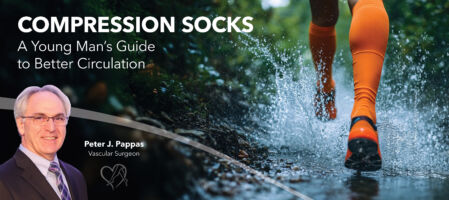
Medically reviewed by Dr. Peter J. Pappas, on June 28, 2025
When you hear “compression socks,” you might think of the elderly and infirm, or patients recovering in a hospital bed, but that image is quickly changing. Here’s the truth: compression stockings are for everyone. Athletes, travelers, and young men and women who are on their feet all day achieve pain relief with these enhanced medical garments.
From easing leg pain and swelling to preventing vein problems, compression socks are a secret weapon for guys (and gals!) who want to stay active, strong, and performing at their best.
For expert advice on compression socks for younger people, we consulted with Dr. Peter Pappas, a vascular surgeon and lead physician at Center for Vein Restoration (CVR) vein clinic locations in Union, New Jersey, and Morristown, New Jersey.
You don’t have to figure it out alone. At Center for Vein Restoration (CVR), our experienced vein specialists will help you choose the right compression level, fit, and style, as well as determine whether your symptoms are signs of a broader vein problem. With more than 110 locations nationwide, expert vein care is nearby. Find your nearest clinic and book an appointment today.
📞 Call CVR at 240-249-8250
📅 Or book online HERE
Compression stockings (also known as compression socks) are stretchy hosiery that applies a gentle squeeze to your legs.
Venous insufficiency means the valves in your veins don’t close properly. This causes blood to back up and pool in your legs, leading to swelling, pain, and visible veins. Compression therapy is a key treatment for supporting healthy circulation and counteracting the effects of blood stagnation in your legs.
Symptoms of venous insufficiency include:
If you’re dealing with leg pain, swelling, or visible veins, or want to stay ahead of potential problems, Center for Vein Restoration (CVR) is here to help. As the nation’s leader in vein care, we specialize in diagnosing and treating venous conditions with compassionate, expert care. Whether you’re new to compression therapy or considering advanced treatment options, our board-certified vein doctors will guide you every step of the way. Schedule your consultation today and feel the difference.
That’s a myth! While symptoms of vein disease like varicose veins and spider veins are more common in people over 50, younger people can have them too, especially if they:
Publications like Business Insider have taken note of the trend that compression socks are becoming popular among younger individuals on social media, especially those who are active, athletic, involved in heavy manual labor, pregnant, or on their feet all day.
Brands like medi, Comrad, and Bombas are driving the trend with stylish, functional designs that appeal to Millennials and Gen Z. Experts recommend a proper fit and pressure for effectiveness, noting that compression socks can be a simple, helpful tool for improving everyday leg health.
Long flights or bus trips mean sitting for hours and not engaging your calf muscles. Compression socks help prevent fluid from collecting in your calves and reduce the risk of deep vein thrombosis (DVT), a serious condition characterized by a blood clot in the veins.
A study reported by the National Library of Medicine (NIH) analyzed 11 randomized trials involving nearly 3,000 airline passengers and found that wearing graduated compression stockings during long flights significantly reduces the risk of silent (asymptomatic) deep vein thrombosis (DVT) from around 10 per 1,000 passengers to just 1–3 per 1,000. The study concluded that compression stockings appear to be a safe, well-tolerated, and effective preventive measure for travelers, with minimal downsides reported.
According to the University of Pittsburgh Medical Center, compression is popular among athletes because it supports muscles and boosts circulation. It improves blood flow and oxygen delivery, which can enhance performance and speed up recovery by reducing lactic acid buildup.
Even if you're not treating a vein problem, using compression socks can help:
Athletes may also experience less muscle vibration, soreness, and fatigue, lowering the risk of injury. Some athletes report feeling more energetic and performing better.
Beware of stockings that are available online. They may not provide adequate pressure and may not fit you properly, especially if you have large limbs.
“Proper fit matters; your compression garment should fit like a second skin.”
Compression stockings are a helpful tool in managing venous disease, but they’re often misunderstood.
Dr. Peter Pappas, a board-certified general and vascular surgeon at Center for Vein Restoration, explains that compression won’t cure vein problems, but it can ease symptoms such as swelling, aching, and leg fatigue. In some cases, compression is also used to meet insurance requirements or help doctors evaluate your response before recommending a procedure.
If you’re considering compression, keep these practical tips in mind:
📞 Call CVR at 240-249-8250
📅 Or book online HERE
Think your heavy, aching legs are just from long days or intense workouts? It might be a sign of chronic venous insufficiency. The good news? Vein problems are highly treatable, especially when caught early. Trust the experts at Center for Vein Restoration to evaluate your symptoms and get you on the path to relief.
Click here to schedule a personalized vein evaluation with a CVR vein expert or call 240-249-8250 for more information.
Compression Can Help, But Expert Vein Care Can Be a Game-Changer
Compression stockings can offer symptom relief, but they’re only one part of the story. If your discomfort persists or worsens, it’s time to see a specialist.
At Center for Vein Restoration, we provide customized, minimally invasive treatment plans backed by the latest research and technology, as well as unmatched expertise. Don’t wait! Book your appointment today and take the first step toward healthier legs.